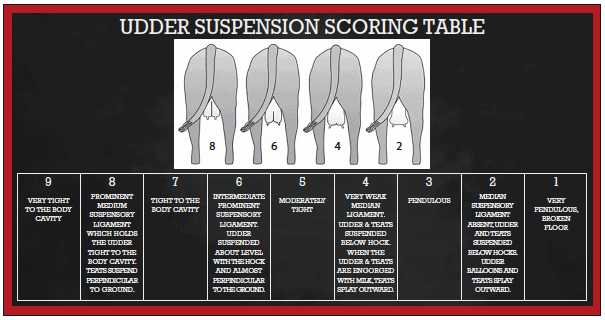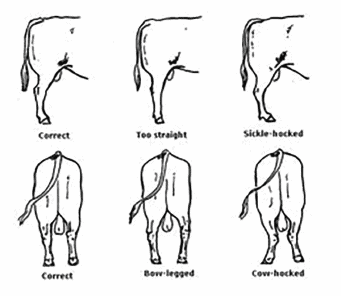Selection Considerations to Improve Longevity
by Associate Professor & Extension Beef Cattle Specialist Longevity Jason Banta, PhD., PAS
Every cow-calf producer wants a cow that is productive for 12 to 15 years or more. Longevity of both cows and bulls is influenced by a host of factors including disposition, feet and legs, udder and teat confirmation, fleshing ability, fertility, function of reproductive organs (e.g. lazy prepuces in bulls), and breed just to name a few. The ability to wean an acceptable calf every year is the primary factor affecting longevity of cows in most operations.
It can be difficult to select for longevity directly. However, we can make selection decisions that reduce the potential reasons that may lead to a cow or bull being culled from the herd. Several breeds including Brangus® have recently started, or will soon start, keeping records on udder suspension, teat size, foot angle, claw set, and disposition. These records can then be used to calculate EPDs to use when selecting bulls.
Disposition is more than just a convenience trait. Research shows that wild or temperamental cattle do not perform as well as their calmer herd mates. Additionally, those wild animals are more likely to injure themselves, tear up fences and working facilities, and worst of all hurt you or someone else. Wild cattle are also more likely to create a situation that if seen by the public or captured on video could result in a negative view of the beef industry by consumers. As a service to the breed, the industry, and their customers seedstock producers need to turn in temperament scores to aid in identifying genetic lines with disposition problems. Disposition is a hereditable trait and is best managed by eliminating wild cattle from both the seedstock and commercial breeding herds.

Udder problems are another reason cows may be culled before reaching the end of their productive life. Poor udder and teat confirmation can make it difficult for calves to nurse leading to reduced consumption of colostrum within the first two hours after calving which leads to reduced calf performance and increased calf mortality. Unlike disposition problems, which can be seen early in life, udder suspension and teat size can’t be accurately evaluated until a heifer calves. Additionally, udder suspension and to a lesser extent teat size can get worse with age so problems may not become apparent until a cow has already had a few calves. Genetic evaluation is the best way to reduce these problems. Unfortunately, one of the biggest unknowns when purchasing bulls is his genetics for udder quality. If you plan to keep heifers, visit with bull breeders about udder quality traits, and when they become available incorporate udder quality EPDs into your selection process.


Poor feet and leg problems can make it uncomfortable to walk. In cows this can lead to reduced time grazing, lower body condition, and ultimately delayed rebreeding or even open cows. In bulls this may lead to reduced breeding activity.

Bull longevity can be reduced because of injuries to the penis and prepuce. Bulls with a lazy prepuce or a very pendulous sheath are at a greater risk for these injuries. In some bulls the prepuce may protrude one to two inches below the end of the sheath while in others it may protrude several inches. Pay attention to the frequency and severity of the protrusion of the prepuce; the risk of injury or infection increases as frequency and severity increase.
Cow longevity can also be improved by paying attention to calving ease. A live calf at birth is the first step to having a quality calf to sell at weaning. Additionally, difficult births can lead to uterine trauma which can delay a cow in returning to estrous and conceiving before the end of the breeding season. This can even occur in situations that don’t require assistance if the birth takes longer than normal or requires extra straining. While the focus is mainly on heifers, calving ease should not be overlooked in cows. Fortunately, genetics are available that allow for both calving ease and good growth.
Breed will also impact cow longevity. Brahman and American (e.g. Brangus, Braford, Beefmaster, etc.) cows will generally remain productive longer than British and Continental cows.
As mentioned earlier, reproduction and the ability of a cow to wean an acceptable calf every year is critical to cow longevity. Cow body condition score at calving has a huge impact on pregnancy rates. To optimize pregnancy rates two- and three-year-old females should be in a body condition score of six or greater at calving. Cows four or older should be in a body condition score of five or greater at calving. Cows that are naturally easy fleshing can make it easier to reach these goals. When selecting bulls to sire replacement heifers, pay attention to ultrasound fat thickness. If two bulls have been managed the same but one bull has a 0.15 inches of rib fat and the other bull has 0.30 inches of rib fat, then the bull with more fat will likely sire daughters that are easier fleshing. I am not saying to buy overly fat bulls; but if the bulls have been fed and managed the same, then the fatter ones in the group will likely sire easier fleshing females.
Weaning weight, yearling weight, and marbling scores may be the talk at bull sales, but don’t forget about the traits that can influence cow and bull longevity. Reducing culling rates in a herd through thoughtful selection of breeding stock will have significant impacts on the economic bottom line of the operation.


